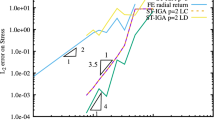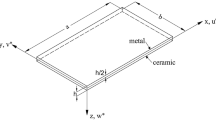Abstract
The problem of steady growth of an antiplane shear crack in a strain rate sensitive elastic-plastic material is considered. It is assumed that the material is elastic-perfectly plastic under slow loading conditions, but that the inelastic strain rate is proportional to the difference between the stress and the yield stress raised to some power. In earlier work on this problem in which the possibility of an elastic region in stress space was not considered, it was concluded that the asymptotic crack tip field is completely autonomous, but the local field could not be shown to reduce to a generally accepted rate independent limit as the rate sensitivity of the material vanished. It is shown here that, if the possibility of elastic unloading is admitted in the formulation, the asymptotic crack tip solution does indeed approach the correct rate independent limit as the rate sensitivity of the material vanishes. Furthermore, the crack tip field loses the feature of complete autonomy under these conditions. That is, the crack tip field involves an undetermined parameter that can be determined only from the remote fields. In the analysis, both dynamic and quasistatic growth are considered.
Résumé
On considère le problème de la croissance stable d'une fissure de cisaillement antiplanaire dans un matériau élastoplastique sensible à la vitesse de déformation. On suppose que le matériau est élastique puis parfaitement plastique en charge lente, mais que la vitesse de déformation inélastique est proportionnelle à la différence entre la contrainte appliquée et la limite élastique, à une certaine puissance. Dans un travail antérieur sur ce problème, où l'on n'avait pas envisagé une région élastique dans l'espace de sollicitations, on avait conclu que le champ asymptotique correspondant à l'extrémité d'une fissure était complètement autonome. Toutefois, on ne pouvait établir que le champ local se réduise à une limite généralement admise comme indépendant de la vitesse, lorsque disparaissait la sensibilité du matériau à la vitesse de sollicitation. Dans la présente étude, on montre qui si on admet dans la formulation la possibilité d'un déchargement en régime élastique, la solution du champ asymptotique à l'extrémité de la fissure se rapproche vraiment de la limite correcte d'indépendance à la vitesse, lorsque disparait la sensibilité du matériau à cette vitesse. En outre, le champ à l'extrémité de la fissure perd ses caractéristiques de complète autonomie sous ces conditions. Ceci veut dire qu'il comporte un paramètre indéterminé, qui ne peut être déterminé qu'à partir des champs de contrainte plus lointains. Dans l'analyses, on a considéré à la fois la croissance dynamique et quasistatique d'une fissure.
Similar content being viewed by others
References
J.R. Rice, in Fracture, Vol. II, ed. H. Liebowitz, Academic Press (1968) 191–311.
A.D. Chitaley and F.A. McClintock, Journal of the Mechanics and Physics of Solids 19 (1971) 147–163.
L.I. Slepyan, Mekhanika Tverdogo Tela 11 (English Translation) (1976) 126–134.
V. Dunayevsky and J.D. Achenbach, International Journal of Solids and Structures 18 (1982) 1–12.
L.B. Freund and A.S. Douglas, Journal of the Mechanics and Physics of Solids 30 (1982) 59–74.
C.Y. Hui and H. Riedel, International Journal of Fracture 17 (1981) 409–425.
K.K. Lo, Journal of the Mechanics and Physics of Solids 31 (1983) 287–305.
L.B. Freund and A.S. Douglas, in Elastic-Plastic Fracture Mechanics, ASTM STP 803, ed. C.F. Shih and J. Gudas, ASTM (1983) 5–20.
F.R.de Hoog and R. Weiss, SIAM Journal on Numerical Analysis 13 (1976) 755–813.
F.R.de Hoog and R. Weiss, SIAM Journal on Numerical Analysis 15 (1978) 198–217.
V. Dunayevsky and J.D. Achenbach, Journal of Applied Mechanics 49 (1982) 646–647.
Author information
Authors and Affiliations
Rights and permissions
About this article
Cite this article
Yang, W., Freund, L.B. An analysis of antiplane shear crack growth in a rate sensitive elastic-plastic material. Int J Fract 30, 157–174 (1986). https://doi.org/10.1007/BF00019774
Received:
Accepted:
Issue Date:
DOI: https://doi.org/10.1007/BF00019774




